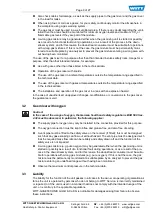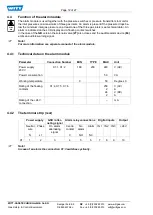
Page 6 of 27
WITT-GASETECHNIK GmbH & Co KG
Salinger Feld 4-8
: +49 (0)2302 89010
www.wittgas.com
Gas Safety- & Control Equipment
D-58454 Witten
Fax: +49 (0)2302 89013
2.5
Terms (in alphabetical order)
In this section the terms necessary to understand this manual are explained.
*
These terms are explained in more detail in the following text.
Alarm module
: The alarm module is on the separate control housing. It signals insuf-
ficient gas inlet pressure* and indicates the corresponding gas.
Constant pressure (P
m
) : The individual gases are reduced to the constant pressure by the
constant pressure regulator unit*. The constant pressure is the pres-
sure of the individual gases from the dome or double dome loaded
pressure regulators.
Constant pressure
regulator unit
: The constant pressure regulator unit comprises dome or double dome
loaded pressure regulators and a pilot pressure regulator*. The gases
to be mixed are regulated to the required constant pressure* by the
constant pressure regulator unit.
Dome loaded pressure
regulator
: A dome loaded pressure regulator functions similarly to a spring-
loaded pressure regulator, however in this case the force from the
spring is replaced by the pilot gas pressure on a membrane. If several
dome loaded pressure regulators are subjected to the same pressure-
regulated pilot gas, then the same constant pressure* is established at
each of the dome loaded pressure regulators.
Double dome loaded
pressure regulator
: A double dome loaded pressure regulator* can be considered as two
single dome loaded pressure regulators*. Both chambers in the dome
loaded pressure regulator are subjected here to a gas, the pilot gas*;
this results in exactly the same pressures being established at the
outlets of the dome loaded pressure regulator. Together with the pilot
pressure regulator*, the dome and double dome loaded pressure
regulators in a gas mixer form the constant pressure regulator unit*.
Gas inlet pressure (P
v
)
: The pressure provided by the supplies for the individual gases is
termed the gas inlet pressure. A differentiation is made between static
and dynamic pressure. If no mixed gas is produced, no gas flows. The
pressures now present at the inlet to the gas mixer are static pres-
sures. However, if mixed gas is produced, the gas inlet pressure
drops to the dynamic pressure as a function of the sizing of the gas
supply.
The static pressure is always higher that the dynamic pressure. The
static pressure (without mixed gas production) must not exceed the
maximum permitted inlet pressure. The dynamic pressure (during the
production of mixed gas) must not drop below the minimum required
gas inlet pressure (in the case that inlet pressure monitoring is acti-
vated, this would result in the triggering of the alarm).
Inlet pressure
monitoring
: The inlet gas pressure monitoring comprises pressure switches* or
pressure transmitter* and an alarm module*. It is used to check for the
minimum gas inlet pressure required. The inlet pressure is only moni-
tored to check if the inlet pressure drops below the min. inlet pressure
given in the technical data.
Mixed gas output (Q
M
)
: The mixed gas output is the mixed gas flow that the gas mixer can
produce in the normal operating state (P=1 bar; T=15 °C). The mixed
gas output will depend on the mixture this value relates to air.







































